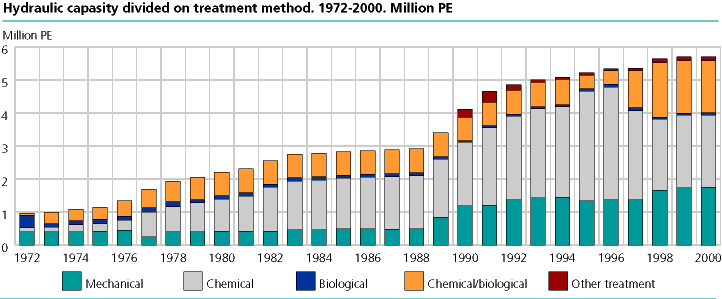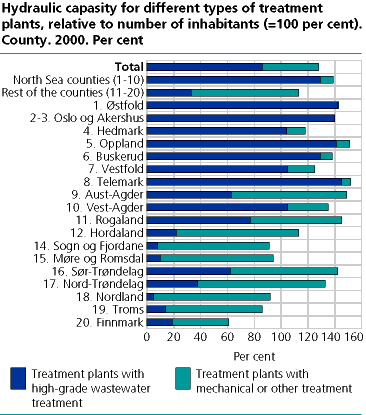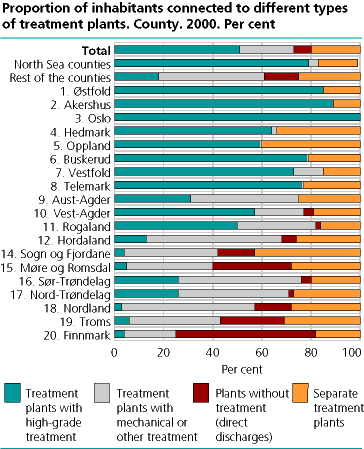Content
Published:
Majority connected to high-grade treatment
Just above fifty per cent of the Norwegian population is connected to wastewater treatment plants using high-grade treatment methods, which includes chemical and biological methods or a combination of these two. In the ten counties draining to the North Sea, more than eighty per cent of the total population is connected to high-grade treatment plants.
The marine areas from the Swedish boarder westwards to the southernmost tip of Norway (referred to as the North Sea area), is categorized as a sensitive area according to the EU Directive on urban wastewater treatment. Norway is also a signatory of the OSPAR Convention and the North Sea treaties. Thus, large investments have been dedicated to construction and improvements of wastewater treatment plants in this area during the last two decades. The statistics presented in this publication are based on reported figures from the municipalities for the year 2000.
Improved treatment capacity
The total hydraulic capacity of wastewater treatment plants in Norway has been increased by 96 per cent since 1988, to 5,72 million population equivalents (PE) in 2000. A part of this increase must, however, be attributed to a change in the registration procedures of mechanical treatment plants. The last five years there has been a significant increase in the number and capacity of combined chemical/biological treatment plants, mainly due to an extension of existing chemical plants in the densely populated areas of eastern Norway.
In 2000, the total treatment capacity in the North Sea counties equaled almost 140 per cent of the area's population, of which high-grade treatment capacity constituted almost 130 per cent. In the other counties the total capacity equaled approximately 113 per cent, of which 32 per cent were high-grade capacity.
Eighty per cent connected to the municipal sewerage system
In 2000, eighty per cent of the total population were connected to the municipal sewerage system. The remaining twenty per cent were mainly connected to separate sewerage systems located in areas of scattered settlements. A total of 1,04 million people were connected to plants with direct discharges of untreated wastewater (including 57 000 people connected to separate plants), while 2,27 million were connected to high-grade treatment plants and just above one million to plants with mechanical or other low-grade treatment. In the North Sea counties only about 18 000 people (including 11 900 people connected to separate plants with no treatment) of a total population of 2,47 million were connected to plants with direct discharges of untreated wastewater.
| Separate treatment plant. Number of plants, persons connected and normal treatment efficiency. 2000 |
| Number of treatment plants | Persones connected | Normal treatment efficiency (Per cent) | |||||||||||||||||||||||||||||||||||||
|---|---|---|---|---|---|---|---|---|---|---|---|---|---|---|---|---|---|---|---|---|---|---|---|---|---|---|---|---|---|---|---|---|---|---|---|---|---|---|---|
| Phosphorus | Nitrogen | ||||||||||||||||||||||||||||||||||||||
| Total | 317 946 | 892 796 | |||||||||||||||||||||||||||||||||||||
| Direct discharges | 20 521 | 57 246 | 0 | 0 | |||||||||||||||||||||||||||||||||||
| Sludge separator | 148 641 | 415 761 | 5 | 5 | |||||||||||||||||||||||||||||||||||
| Mini wwtp, biological | 1 272 | 3 419 | 15 | 10 | |||||||||||||||||||||||||||||||||||
| Mini wwtp, chemical or chemical/biological | 3 467 | 9 236 | 90 | 15 | |||||||||||||||||||||||||||||||||||
| Sludge separator with infiltration | 97 163 | 275 313 | 75 | 20 | |||||||||||||||||||||||||||||||||||
| Sludge separator with sandfilter | 31 340 | 83 909 | 15 | 15 | |||||||||||||||||||||||||||||||||||
| Separate toilet system | 10 644 | 33 900 | 95 | 95 | |||||||||||||||||||||||||||||||||||
| Sealed tank | 4 898 | 14 013 | 100 | 100 | |||||||||||||||||||||||||||||||||||



